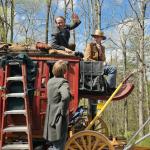 Channing Eleton is one of the premiere pianists in southern gospel, but I was first introduced to him through his music video of “Up On This Ridge.” It was smartly produced and gave me an excellent taste of the folk/country fusion Channing has created with his vocal work. I also caught an outstanding piano solo from him during NQC this year and noted the fact that he played with no backing track. He allowed the piano to speak for itself, and it was classy.
Channing Eleton is one of the premiere pianists in southern gospel, but I was first introduced to him through his music video of “Up On This Ridge.” It was smartly produced and gave me an excellent taste of the folk/country fusion Channing has created with his vocal work. I also caught an outstanding piano solo from him during NQC this year and noted the fact that he played with no backing track. He allowed the piano to speak for itself, and it was classy.
So after reading this review of his new project by DBM, I knew I had to check it out. So I did. While I enjoyed it, it didn’t quite live up to my expectations. On the one hand, I was blown away by Channing’s incredible musicianship and versatility, as he plays most of the key instruments on the project as well as writing or co-writing four of the songs (plus, of course, singing). I was also impressed by the creativity of the project. Channing is definitely branching out from typical SG and working to offer something different and fresh. At times this sounds like Bruce Hornsby meets Michael Card—no exaggeration. And yet, some of the songs just didn’t connect with me at all, while a few of the standouts in terms of song selection didn’t mesh with Channing’s voice. It’s a perfectly serviceable voice, a rough, down-to-earth country baritone, but the problem is that it just doesn’t always click with the songs he picked.
Ultimately, I came away glad I’d given it a spin but thinking about what could have been. But now to get specific with a track-by-track.
1. Days: I said Bruce Hornsby, and I wasn’t kidding. Think “The Old Playground.” The lyrics aren’t particularly remarkable—a pleasant meditation on getting one’s priorities right in life. But it’s all about that piano. It’s all about that B-3 Hammond. It’s all about that beat. And it’s all about the magic they’re making together.
2. The Harvest: Any “harvest” song is always going to get compared in my mind to the Imperials’ classic “Lord of the Harvest.” That song is so good that it makes it unfair for other good songs with a similar theme, like this one. However, while I admit that this isn’t as good as “Lord of the Harvest,” it is well-crafted in its own right. My main beef with it is that the tune doesn’t have that much to it, something I actually noted with several of these tracks. But the arrangement is classy and tasteful.
3. Up On This Ridge: Arguably the best track on the album. Everything comes together perfectly here. The song itself is good, it fits Channing’s voice, and the instrumentation is sterling. Instead of describing it in detail, I’ll let you watch its music video:
4. Is This Not the Land of Beulah: I must shame-facedly admit that this apparent classic had slipped under my radar before I encountered it on this album. The arrangement is delightful, carried by a willowy hammered dulcimer and fortified by accordion. The interesting arrangement helps to make up for the fact that this is a very long song with many verses, the kind of thing that would normally bore me. It clocks in at nearly six minutes. Because of its length, it may not be a track that gets repeated a lot by me, but I have great respect for the musicianship it displays.
5. Song and Dance: In a surprising move that nonetheless shows excellent taste, Channing opts to cover an Andrew Peterson song. Believe it or not, devoted AP fan as I am, this was one song I hadn’t chanced upon yet. It’s signature Andrew Peterson, which means the lyrics are intricate and beautiful, and the melody meanders somewhat. It paints a picture of the psalmist David sitting on his throne, chuckling over the memory of Goliath and preparing to pen a fresh ode to God as all nature sings around him. Eleton’s arrangement takes a Celtic approach, featuring some lovely pipe work. Once again, the production leaves absolutely nothing to complain about, but the song selection isn’t quite as strong as it could have been. While I like this song, it doesn’t rank among the very best Peterson has written. The melody is a little weak even for him. I would have preferred to hear Channing’s take on a song like “Lay Me Down.” Still, bravo for a song choice that’s unexpected and fresh.
6. Looking to Jesus: This black gospel classic features some rompin’ musicianship. Channing gets to demonstrate his piano chops on an instrumental bridge. This is obviously a comfortable niche for his slightly rough vocals. As is typical of this kind of song, the melody is pretty repetitive, but the arrangement is so good I consider this to be a highlight.
7. Creation Song (Glory to the Lamb): In yet another surprising but pleasing move, Channing covers a Fernando Ortega song. The song itself is gorgeous, but while I enjoy the arrangement, I must admit that I much prefer Fernando’s original. His voice fits the song much better than Channing’s. However, as with Andrew Peterson, I give Channing mad props for going outside the box and picking music from a great artist whose work doesn’t even border on southern gospel.
8. As We Wait: This song is pretty boring, if I’m being honest. I mean, there’s nothing wrong with it, it’s a nice worship tune, but nothing really grabs me about it. It might hold a little more interest for me if somebody like Twila Paris was singing it.
9-10 Just This Song: This is in two parts, a fully instrumental piano prelude and the song itself. The prelude is lush, understated, and gorgeous. The song, unfortunately, is a snoozer. It meanders musically and suffers from cliched lyrics. I just couldn’t stop thinking about all the vastly better songs I had heard that dealt with the same theme, particularly the Imperials’ “One More Song For You.” Plus Channing’s delivery is flat and sleepy, but there’s not much to work with anyway. Listening to the song and its prelude back-to-back only reinforces the fact that Channing is an utterly brilliant musician, but his singing and writing skills are merely competent.
As you saw, there were several cases where I found myself saying, “This song is okay, but there’s another really similar song that’s much better,” and so on. It may have been less of an issue on a project with a couple more tracks, but at nine songs plus a piano interlude, weak or average cuts are harder to afford. And yet the production is so good that the album as a whole is hard not to like. The end effect is definitely a “whole greater than the sum of its parts” feeling. As DBM says, it takes immense talent to wear so many hats on one recording and produce something quality that’s worth listening to, which this project definitely is. It’s just that it could have been great instead of simply above average. I hope that Channing produces another project with the same top-notch level of musicianship displayed in an even better crop of songs.












